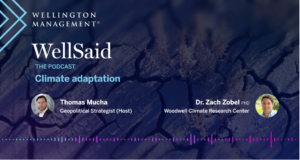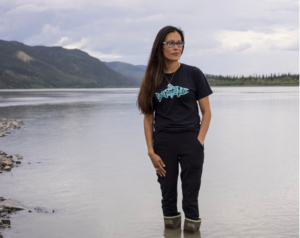Arctic wetlands are known emitters of the strong greenhouse gas methane. Well-drained soils, on the other hand, remove methane from the atmosphere. In the Arctic and boreal biomes, well-drained upland soils cover more than 80% of the land area, but their potential importance for drawing methane from the atmosphere—the underlying mechanisms, environmental controls and even the magnitude of methane uptake—have not been well understood.
A recent study led by researchers from the University of Eastern Finland and University of Montreal, in collaboration with Woodwell Climate Research Scientist, Dr. Anna Virkkala, has expanded our understanding of these dynamics, finding that Arctic soil methane uptake may be larger than previously thought. The results show uptake increasing under dry conditions and with availability of a type of soil organic carbon that can be used in microbial uptake processes.
The study was primarily conducted at Trail Valley Creek, a tundra site in the Western Canadian Arctic. The authors used a unique experimental set-up consisting of 18 automated chambers for continuous measurements of methane fluxes. No other automated chamber system exists this far North in the Canadian Arctic, and only few exist above the Arctic circle globally, most of which are installed at methane-emitting sites.
The high-resolution measurements of methane uptake (more than 40,000 flux measurements) revealed previously unknown daily and seasonal dynamics: while methane uptake in early and peak summer was largest during the afternoons, coinciding with maximum soil temperature, uptake during late summer peaked during the night. The study shows that the strongest methane uptake coincided with peaks of ecosystem carbon dioxide respiration—meaning that as methane is removed from the atmosphere, carbon dioxide production in the soil is high. Complementing flux measurements at Trail Valley Creek with measurements at other sites spread across the Canadian and Finnish Arctic showed that the availability of soil organic carbon and other nutrients may promote methane consumption in Arctic soils.
“The methane cycle has previously been primarily studied in wetlands because of their high methane emissions, but this study shows that drier ecosystems are also very important in the methane cycle,” says Dr. Virkkala.
These findings are highly relevant for estimating the current Arctic carbon budget, and for predicting the future response of Arctic soil methane uptake to a changing climate. According to the study, high-latitude warming itself, occurring up to four times faster in the Arctic than the rest of the world, will promote atmospheric methane uptake to a lesser extent than the associated large-scale drying.
“The Arctic methane budget has remained highly uncertain,” remarks the paper’s lead author, Dr. Carolina Voigt. “Our research provides one potential mechanism that might explain those uncertainties, and highlights the importance of methane measurements in drier ecosystems to calculate more accurate methane budgets.”
Climate change is having profound effects on the chemical composition of large Arctic rivers, signaling changes both on land and in the coastal ocean, according to new international research examining chemical signatures in rivers across Canada, Alaska and Russia.
The study, the result of a two-decade effort by the Arctic Great Rivers Observatory, analyzed nearly twenty years of water chemistry and discharge data collected from six rivers that comprise 60 percent of the Arctic Ocean watershed.
The researchers tracked river water ions, key nutrients, and dissolved organic carbon, among other indicators. They found that chemical concentrations changed substantially over the past two decades, but trends across chemical groups were different, with some increasing, some decreasing, and others showing little change.
The international scientific collaboration tracked river water ions, key nutrients and dissolved organic carbon among other metrics. Chemical concentrations changed substantially over the past two decades, but trends across chemical groups were different with some increasing, some decreasing, and some showing little change.
“The only way that this divergence in trends is possible is if multiple factors of change are being brought to bear on the Arctic system at the same time,” says Woodwell Research Assistant, Anya Suslova and co-author on the paper. “We know that permafrost is thawing, vegetation is changing and moving northward, and processing of nutrients and organic matter may be happening more quickly. Global climate change appears to be causing many systems that are critical for ecosystem function to change at the same time—and that change is showing up in the chemical composition of river water.”
Key nutrients observed in river water are declining, according to the study. This trend suggests warming temperatures are increasing biological uptake of nutrients on land or in aquatic ecosystems, leading to an overall decrease despite factors like wildfire and permafrost thaw releasing more nutrients into the waterways.
ArcticGRO represents a partnership between researchers at Woodwell Climate Research Center, University of Alberta, the Marine Biological Laboratory, Florida State University, and the University of New Hampshire, as well as scientific and community collaborators in Siberia and the North American Arctic.
“The success of this study is largely due to its collaborative nature,” says Dr. Max Holmes, Woodwell Climate President and CEO, and founder of the ArcticGRO project. “Without the dedication of scientists and community members across the Arctic, we never would have been able to generate the comprehensive dataset that allowed us to uncover these insights.”
Because trends in river water chemistry are not always acting in the same direction, Dr. Holmes and Suslova say the study will help give scientists a blueprint for thinking about how Arctic change will play out.
Is Earth’s largest heat transfer really shutting down?

With unprecedented heat waves and record-breaking global temperatures, it’s hard to believe that there might be a place on earth that has actually COOLED since the industrial revolution. But, it turns out, there is such a spot. The COLD BLOB off of Greenland mystified scientists for years, but new studies have uncovered a scary reality – this cool patch might be a warning of the impending collapse of a vital earth circulation system. And the consequences would be dire. In this episode of Weathered, we travel to the Gulf Stream with the new PBS Terra show Sharks Unknown to experience the AMOC first hand. And we ask, what is the likelihood that the AMOC will collapse, and what would the consequences be?
How a mix of natural and human-caused factors cooked up Tropical Storm Hilary’s soggy mess

A natural El Nino, human-caused climate change, a stubborn heat dome over the nation’s midsection and other factors cooked up Tropical Storm Hilary’s record-breaking slosh into California and Nevada, scientists figure.
Cooked up is the key phrase, since hot water and hot air were crucial in rapidly growing Hilary and then steering the storm on an unusual path that dumped 10 months of rain in a single weekend in normally bone-dry places. Nearly a foot of rain fell in parts of Southern California’s mountains, while cities smashed summertime records.
Read more on Associated Press News.
Climate adaptation – A conversation with Woodwell Climate Research Center

Wellington Director of Climate Research Chris Goolgasian and Dr. Zach Zobel of Woodwell Climate Research Center join podcast host Thomas Mucha to share their perspectives on the adaptation research and investing landscape.
AI for the planet: How one of the world’s biggest tech firms is backing AI-powered climate science

Last summer, as the COVID-19 pandemic settled into a state of relative control, Google.org turned its attention to an even larger and more complex global emergency: climate change. The corporate philanthropy’s 2022 Impact Challenge on Climate Innovation — the latest in its decade-long series of Impact Challenges on various topics — committed $30 million to
support “big bet” projects that accelerate technological innovation in climate information and action. Google.org would back six projects at up to $5 million each, for up to three years. Projects that make use artificial intelligence technology were encouraged — the effort aims to understand what’s going on in a changing planet and develop tools to help communities adapt to and minimize harmful and disruptive impacts.
Continue reading on Inside Philanthropy.
Salmon Stories | Brooke Woods

“My parents raised their six children at fish camp right above our village of Rampart, on the Yukon River. I have very fond memories of being at camp. Multi-generation family members together harvesting salmon. Family members coming from different villages and cities to come and fish together.
For me that was a sense of peace and community, kinship and well being. Everything was fine and well when we were processing fish together.”



